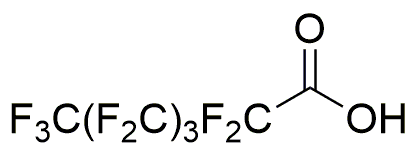Undecafluorohexanoic acid is widely utilized in research focused on:
- Fluoropolymer Production: This compound serves as a key ingredient in the synthesis of fluoropolymers, which are known for their exceptional chemical resistance and thermal stability. These properties make them ideal for applications in coatings and sealants used in the automotive and aerospace industries.
- Surface Treatment: It is used in surface modification processes to enhance the hydrophobicity and oleophobicity of materials. This application is particularly beneficial in textiles and consumer goods, providing water and stain resistance.
- Environmental Research: Researchers utilize undecafluorohexanoic acid in studies related to environmental persistence and bioaccumulation of fluorinated compounds, helping to assess their impact on ecosystems and human health.
- Analytical Chemistry: This compound is employed as a standard in analytical methods to detect and quantify fluorinated substances in various matrices, aiding in regulatory compliance and safety assessments.
- Biomedical Applications: Its unique properties are explored in drug delivery systems, where it can improve the solubility and stability of therapeutic agents, enhancing their efficacy in medical treatments.
General Information
Properties
Safety and Regulations
Applications
Undecafluorohexanoic acid is widely utilized in research focused on:
- Fluoropolymer Production: This compound serves as a key ingredient in the synthesis of fluoropolymers, which are known for their exceptional chemical resistance and thermal stability. These properties make them ideal for applications in coatings and sealants used in the automotive and aerospace industries.
- Surface Treatment: It is used in surface modification processes to enhance the hydrophobicity and oleophobicity of materials. This application is particularly beneficial in textiles and consumer goods, providing water and stain resistance.
- Environmental Research: Researchers utilize undecafluorohexanoic acid in studies related to environmental persistence and bioaccumulation of fluorinated compounds, helping to assess their impact on ecosystems and human health.
- Analytical Chemistry: This compound is employed as a standard in analytical methods to detect and quantify fluorinated substances in various matrices, aiding in regulatory compliance and safety assessments.
- Biomedical Applications: Its unique properties are explored in drug delivery systems, where it can improve the solubility and stability of therapeutic agents, enhancing their efficacy in medical treatments.
Documents
Safety Data Sheets (SDS)
The SDS provides comprehensive safety information on handling, storage, and disposal of the product.
Product Specification (PS)
The PS provides a comprehensive breakdown of the product’s properties, including chemical composition, physical state, purity, and storage requirements. It also details acceptable quality ranges and the product's intended applications.
Certificates of Analysis (COA)
Search for Certificates of Analysis (COA) by entering the products Lot Number. Lot and Batch Numbers can be found on a product’s label following the words ‘Lot’ or ‘Batch’.
Numéro de catalogue
Numéro de lot/série
Certificates Of Origin (COO)
This COO confirms the country where the product was manufactured, and also details the materials and components used in it and whether it is derived from natural, synthetic, or other specific sources. This certificate may be required for customs, trade, and regulatory compliance.
Numéro de catalogue
Numéro de lot/série
Safety Data Sheets (SDS)
The SDS provides comprehensive safety information on handling, storage, and disposal of the product.
DownloadProduct Specification (PS)
The PS provides a comprehensive breakdown of the product’s properties, including chemical composition, physical state, purity, and storage requirements. It also details acceptable quality ranges and the product's intended applications.
DownloadCertificates of Analysis (COA)
Search for Certificates of Analysis (COA) by entering the products Lot Number. Lot and Batch Numbers can be found on a product’s label following the words ‘Lot’ or ‘Batch’.
Numéro de catalogue
Numéro de lot/série
Certificates Of Origin (COO)
This COO confirms the country where the product was manufactured, and also details the materials and components used in it and whether it is derived from natural, synthetic, or other specific sources. This certificate may be required for customs, trade, and regulatory compliance.

